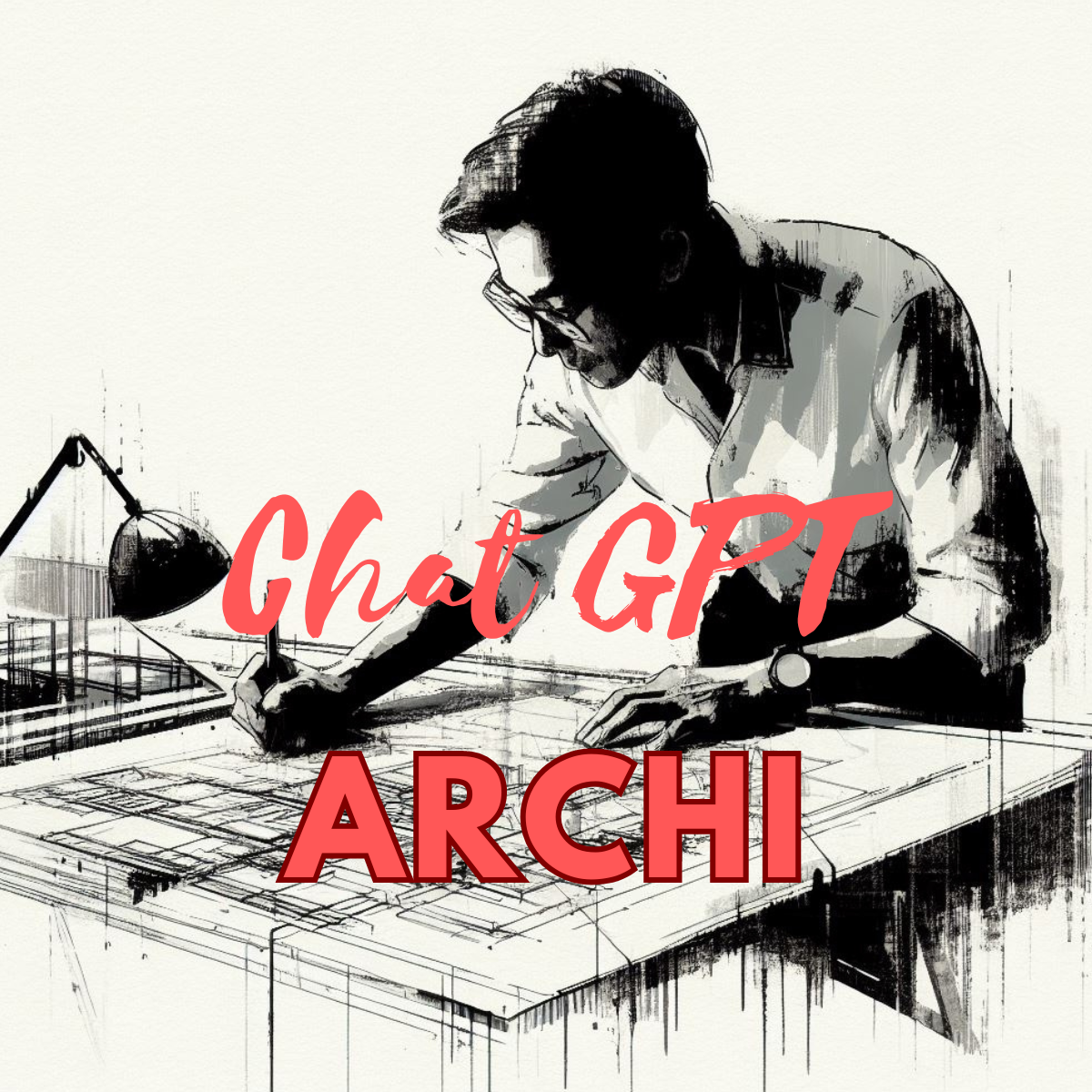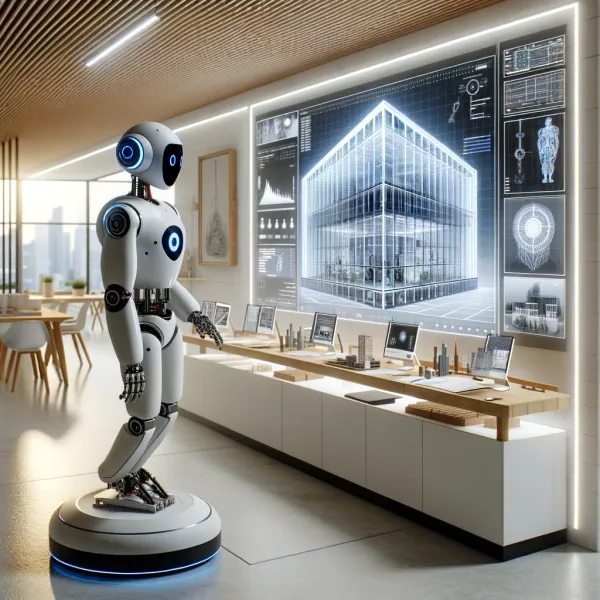Chat GPT for architects
ChatGPT for architects allow to work faster and design better projects learn how.

Artificial Intelligence (AI) technology has transformed numerous industries, and architecture is no exception. Architects today are using chat GPT (Generative Pre-trained Transformer) models to improve the design process, enhance collaboration, and overcome design challenges.
I have an online course where you could learn how to automate your architecture studio work to save time while designing better projects.
This AI in AI in AEC online course is by subscription with one lesson a week.
In this article, we'll explore the best chat GPT prompts for architects, providing insight into how AI can enhance design creativity and project efficiency in the field of architecture. But first, let's understand what chat GPT is.
Key Takeaways:
- Chat GPT is a chatbot model powered by the GPT algorithm.
- Architects can leverage chat GPT for design inspiration, project management, and problem-solving.
- Specific features to look for in chat GPT for architects include architectural terminology support and project management integration.
- Chat GPT prompts can assist architects in addressing design challenges, such as incorporating sustainable design principles and addressing accessibility requirements.
- Training and fine-tuning chat GPT models for architecture involves integrating architectural knowledge and customizing prompts.
What is Chat GPT?
Before we dive into the specific prompts for architects, it's important to understand what chat GPT is.
Chat GPT is a state-of-the-art language processing AI developed by OpenAI, designed to understand and generate human-like text based on the input it receives.
GPT, which stands for "Generative Pretrained Transformer," utilizes deep learning algorithms to analyze patterns in data, allowing it to engage in a wide array of tasks—from conversational responses and creative writing to answering questions and providing explanations.
Its versatility and advanced understanding of context and nuance have made it an invaluable tool for educators, programmers, writers, and businesses looking to harness the power of natural language processing to enhance their operations and offer more intuitive user experiences.
The Benefits of Using Chat GPT in Architecture
Chat GPT is an AI-powered tool that can greatly benefit architects by enhancing their design creativity and project efficiency. Here are some of the advantages of using chat GPT in architecture:
Streamlining Design Process
By interacting with chat GPT prompts, architects can explore new design ideas, seek inspiration, and receive feedback in real-time. This can help streamline the design process and facilitate collaboration among team members, resulting in better design outcomes.
Enhancing Collaboration
Chat GPT can also improve the collaboration between architects by enhancing communication and providing a platform for sharing design intents, ideas, and concepts. With chat GPT, architects can easily share and receive feedback from their peers, helping them refine their design ideas and improve project communication.
Efficient Design Recommendation
Chat GPT can also provide architects with efficient design recommendations by analyzing the project requirements and generating design alternatives that meet the criteria. This can save architects significant time and effort by automating the design process.
Optimizing Project Management
Through chat GPT, architects can optimize project management by facilitating real-time communication, assisting in decision-making processes, and providing reminders and notifications to keep the project on track. This can improve project efficiency and reduce the risk of delays or errors.
Overall, chat GPT presents an exciting opportunity for architects to harness the power of AI in their design process. By leveraging chat GPT, architects can unlock new levels of creativity, collaboration, and efficiency in their projects, resulting in better design outcomes and improved project management.
Key Features to Look for in Chat GPT for Architects
When it comes to choosing the best chat GPT prompts for architects, it's important to consider certain features that cater to their unique needs and requirements.
Architectural Terminology Support
Look for chat GPT models that are trained on architectural terminology and can understand industry-specific jargon. This ensures that the model generates more relevant and accurate responses to the architect's queries.
Design Recommendation Capabilities
Opt for chat GPT prompts that can offer design recommendations based on specific requirements and constraints. The model should be able to generate relevant ideas and suggestions that align with the architect's design vision and objectives.
Project Management Integration
Choose chat GPT models that can integrate with project management tools and platforms, allowing for seamless communication and collaboration among architects and stakeholders. This ensures that the model can assist with project coordination and decision-making processes.
Understanding Architectural Constraints
Ensure that the chat GPT prompts are capable of understanding architectural constraints and limitations, such as zoning laws, building codes, and material compatibility. This enables the model to generate responses that are feasible and can be implemented in real-world scenarios.
Prompts for Design Inspiration and Exploration
Chat GPT prompts can be an excellent source of inspiration for architects looking to explore unique design ideas. These prompts can help architects overcome creative blocks by generating new concepts and designs based on specific keywords or themes.
Here are some of the best chat GPT prompts for architects:
- Concept generator: This prompt generates concept sketches based on keywords provided by the architect. The resulting sketches can inspire new design ideas and help architects think outside the box.
- Style suggestion: This prompt provides architects with design suggestions based on specific architectural styles or themes. This can help architects explore new design territories and experiment with different design aesthetics.
- Material recommendation: This prompt generates recommendations for building materials based on the architect's design specifications. This can help architects make informed decisions about the materials they use and ensure the sustainability and longevity of their designs.
Using these prompts, architects can unleash their creativity and discover new design possibilities that they may not have considered before. Moreover, chat GPT can provide architects with instant feedback, allowing them to refine their designs in real-time and collaborate more effectively with other stakeholders.
Indeed, chat GPT has the potential to revolutionize the architecture industry and enhance the way architects design and build. With the right prompts and tools, architects can leverage AI to create more innovative, sustainable, and functional designs that meet the needs of our rapidly changing world.
Collaborative Project Management with Chat GPT
The benefits of chat GPT in architecture extend beyond design exploration and inspiration. Collaborative project management is another area where chat GPT can significantly enhance efficiency and communication among architects.
Real-time communication is essential in design projects, and chat GPT can provide instant feedback and collaboration opportunities for architects. By integrating chat GPT prompts into project management tools, architects can streamline communication channels, allowing for smoother decision-making processes and more efficient project coordination.
Chat GPT can also assist in managing project timelines and reducing delays. By automating routine tasks such as scheduling meetings and sending reminders, architects can focus on project tasks that require more attention and creativity.
Furthermore, chat GPT can help teams stay on track with project goals and objectives. By visualizing progress and tracking project milestones, architects can ensure that the project is moving forward as planned.
Table: Examples of Chat GPT Project Management Features for Architects
| Feature | Description |
|---|---|
| Real-time communication | Ability to interact with team members and stakeholders instantly for feedback and collaboration. |
| Automated task management | Automating routine tasks such as scheduling meetings and sending reminders to improve efficiency and focus on critical project tasks. |
| Progress tracking | Visualizing project progress and tracking milestones to ensure that the project is moving forward as planned. |
By utilizing chat GPT for collaborative project management, architects can take their design projects to the next level, with improved communication, a streamlined process, and efficient project coordination.
Overcoming Design Challenges with Chat GPT
Architects face numerous design challenges that can impact project outcomes. However, with the help of chat GPT prompts, architects can overcome these challenges and achieve their design vision. Here are some key ways in which chat GPT can assist architects in overcoming design challenges:
Complex Architectural Problems
Chat GPT prompts can help architects solve complex architectural problems by offering alternative design solutions based on different criteria. The model can generate various design combinations that meet specific requirements, like maximizing natural light, minimizing energy consumption, or accomodating accessibility needs.
Optimizing Space Utilization
By using chat GPT to explore different design options, architects can optimize the utilization of space. The model can generate designs that utilize space more efficiently, provide comfortable spaces for users, and maximize flexibility for future usage.
Incorporating Sustainable Design Principles
Chat GPT can assist architects in incorporating sustainable design principles into their projects. By generating prompts that emphasize the importance of energy-efficient designs, sustainable materials, and green spaces, architects can create projects that align with environmental goals and regulations.
Addressing Accessibility Requirements
The use of chat GPT can help architects address accessibility requirements in their designs. By providing prompts to ensure proper mobility, functionality, and usage for all people, including those with disabilities, architects can create projects that adhere to accessibility standards and improve the user experience for everyone.
The benefits of chat GPT for architects are clear. From streamlining the design process to enhancing project efficiency, chat GPT holds enormous potential for architects and their clients. By leveraging the power of AI in architecture, architects can innovate and revolutionize their approach to design.
Conclusion
Chat GPT is an innovative technology that architects can leverage to enhance their design process and collaboration. By using the best chat GPT prompts for architects, designers can unlock new levels of creativity, efficiency, and productivity. With AI in architecture, architects can solve complex design challenges and optimize space utilization while incorporating sustainable design principles and addressing accessibility requirements.
As we saw in this article, chat GPT can assist architects in several ways, including design inspiration, project management, collaborative decision-making, and overcoming design challenges. It's essential to note that choosing the right chat GPT model for architecture is crucial. Architects should look for features like architectural terminology support, design recommendation capabilities, project management integration, and the ability to understand architectural constraints.
In conclusion, architects can revolutionize their design practice by embracing the potential of AI in architecture. With chat GPT, designers can interact with machine-generated prompts to explore new design ideas, seek inspiration and feedback, and collaborate efficiently with other team members. So why not incorporate chat GPT into your workflow and unlock a whole new world of design possibilities?
Want to learn AI and ChatGPT as an architect?
You want to learn AI and ChatGPT for AEC?
I prepare an online course where you could learn how to automate your architecture studio work to save time while designing better projects.
This ChatGPT for architects online course will be ready in early 2024, so leave your email to be notified when we launch!
FAQ
What is chat GPT?
Chat GPT refers to chatbot models powered by the Generative Pre-trained Transformer (GPT) algorithm. These models are trained on large amounts of text data and can generate human-like responses in a conversational manner.
How can architects benefit from using chat GPT?
Architects can leverage chat GPT to streamline their design process and enhance collaboration. By interacting with chat GPT prompts, architects can explore new design ideas, seek inspiration, receive feedback, and improve project communication.
What key features should architects look for in chat GPT models?
When choosing a chat GPT model for architecture, it's important to consider features like architectural terminology support, design recommendation capabilities, project management integration, and the ability to understand architectural constraints.
What kind of prompts can help architects with design inspiration and exploration?
There are a variety of chat GPT prompts that can spark design inspiration for architects. These prompts can range from generating concept sketches based on keywords to offering design suggestions based on architectural styles or themes.
How can chat GPT assist in collaborative project management for architects?
Chat GPT can improve project management and collaboration among architects by facilitating real-time communication, aiding in decision-making processes, and providing an efficient tool for project coordination.
Can chat GPT help architects overcome design challenges?
Yes, chat GPT prompts can assist architects in overcoming design challenges. They can help in solving complex architectural problems, optimizing space utilization, incorporating sustainable design principles, and addressing accessibility requirements.
How can chat GPT be trained and fine-tuned for architecture?
Training and fine-tuning chat GPT models for architecture involve customizing prompts, integrating architectural knowledge, and improving the model's performance to cater to architect-centric applications.
What are the benefits of using chat GPT for architects?
Using chat GPT allows architects to harness the power of artificial intelligence in their design process, unlocking new levels of creativity, efficiency, and collaboration in their projects.



